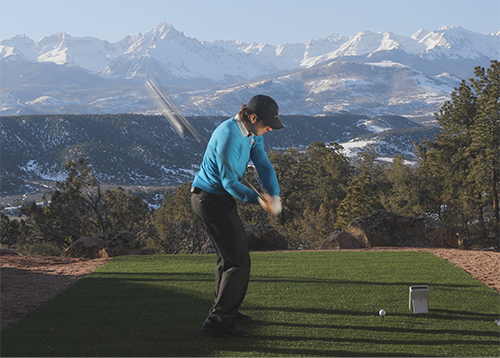Jason Day vs. Jordan Spieth
Jason Day vs. Jordan Spieth
Description
Jason Day, 2015 PGA Champion and Jordan Spieth, square off in this golf swing analysis. I'll show you how one of the players is more safe and efficient at impact.
Video Practice Points
- Make sure you are stable in the hitting area by transferring your weight and attaining neutral joint alignment.
- The hips need to shift and rotate in the downswing.
- Pushing from the trail side can cause you to roll to the outside part of your ankle.

Jason Day Swing vs. Jordan Spieth Swing
Are you looking for a way to put more speed in your golf swing? More importantly, are you wanting to make sure that you can do it in a safe way so that you do not hurt at the end of a round?
Jason Day's swing is a great example of making big clubhead speed all while doing it a very safe way. What do I mean by saying “in a very safe way”? Well, that is what we are going to cover now.
If you watched the 2015 PGA Championships, you would have seen Jason Day dominate the field at Whistling Straits Golf Club. He set a new major championship record by hitting a benchmark of 20 under par. No player in the history has have done so.
Jason day was not in short company though. He stepped onto the first tee with the newest #1 player in the world, 22 year old sensation, Jordan Spieth. Who by the way, won 2 major championships in 2015 and was in extremely close contention for the other 2.
When you look at how far the modern day golf swing has come, you will notice a huge difference from those players in the Ben Hogan/Jack Nicklaus era. But, why is that?
Golf has evolved not only from a technology standpoint, but has also evolved in way that golfers have now learned how to move their bodies in a much more controlled way. We have learned how to swing the golf club in a way that requires less moving parts, with an end goal of producing maximum speed and consistency all at the same time.
If you stop and look at the Ben Hogan or Jack Nicklaus golf swing eras, you will see that the swings had tons of body rotation and trail side push. The result of these movements over time, has been deemed the main culprit for hip and knee injuries surfacing later in life.
Now, that does not mean the trend to golf instruction is now completely centered around biomechanics and kinesiology. Unfortunately, the importance of protecting the body is still trying to play “catch up”.
When you watch the beautiful golf swings on T.V., and you see players like Jordan Spieth, it is extremely hard to not wonder what it would be like to swing the golf club just as he does.
Jordan Spieth does have an immense amount of talent and will probably go down in the history books as one of the greatest putters of all time. However, if you stop and look at his impact position, there is a glaring problem with the way he rolls to the outside part of his lead ankle. This sort move in the golf swing, can put a ton of stress on the ligaments in the ankle and also put stress on the lead hip or knee. Over time, this can cause severe deterioration and could put Spieth on the sidelines until he corrects the issue.
There are players that have learned more safe ways to swing the golf club. Enter Jason Day...
If you watch Jason sit into his left side, you will see that he moves his left knee into neutral joint alignment. He then continues to shift his weight and also rotate his hips while doing so. Day is great about maintaining stability in his left leg at impact uses the ground for a boat load of leverage, resulting it more power and a much better impact position than Spieth.
If you are uncertain about what a good biomechanical and anatomically correct golf impact position is supposed to look like, then I strongly encourage you to look at “Impact alignments - face on” video and get a clear answer of what you will be looking for in your own swing.
Looking at the golf swing and having a clear understanding of what the body can and cannot tolerate over time, is extremely important for your success in efficiency as well as being able to play the game for a long period of time.
Each of our bodies is designed to move a certain way. It is our responsibility to teach you students of the game the safest way to create speed and control. Take control of your golf swing and make sure you are working to protect and preserve the body while doing so.
Hey guys. This is RST instructor Chris Tyler and we are back again with this week's tour analysis on the 2015 PGA champion Jason Day's golf swing. So congratulations to Jason. I'm going to be squaring him off against the new number one player in the world, 22 year old sensation Jordan Spieth. I'm going to be showing you guys a very glaring difference in their impact positions, so if you've been struggling with possibly a knee issue or a hip issue, you want to play close attention to this review because I'm going to show you guys a great way to make sure that you're not putting your body in any sort of harm's way and you're also making sure that you have a very efficient golf swing from beginning to end.
Okay guys, so if you got to watch any golf this past weekend then you would have probably seen a pretty exciting event where Jason Day pretty much took Whistling Straits to its knees and shot 20 under par out there. Lots of great scoring, lots of great play from a lot of golfers out there and saw a lot of great sportsmanship too. We saw Jordan obviously cheering Jason on there towards the end on 17 where he gave him the thumbs up on his lag putt. That just shows a lot about Jordan's character and shows the amount of respect that these guys have for one another.
That kind of segues into my next comment here. When we start to do these tour videos here, we start to break down some of these player's swings, if we point out a particular position in the golf swing that could be either harmful or could be detrimental to what they're doing, by no means is that any sort of bashing. We don't ever want to bash these players. Both these players are great advocates for the game of golf. They're pushing kids to work harder these days. You see a lot of players continuing to work on their bodies and become stronger and stronger, so if we point something out like that the whole point is that we want to make sure that you can play the golf for many years to come without putting your body in harm's way.
That's really kind of the big thing around modern day golf is that, that one glaring fact out there that kind of 80 to 81 percent of tour pros will sustain a golf related injury that keeps them out of golf for eight weeks or more. That's a pretty high number and we want to make sure we're doing what we can to be able to protect and preserve the body because you can put a lot of stress on it in certain areas so without further ado here, when we start talking about some things, obviously this is by no means me bashing either one of these players. Both these players are just awesome.
So I'm going to go ahead and mark some things here at the start. We're going to mark the head position of Jordan, mark the head position of Jason. Camera angles might be just a little bit different here. This one on Jason's just a little bit off to the side, where Jordan's is more of a face on perspective. You'll see both players start to work into their take away beautifully. Go through some of these early things pretty quickly so we can get down to the impact position that we were talking about.
You can see that both players get nice and wide, a little bit of movement from the head, inch, inch and a half or so. That's perfectly fine. We know that when we go to a little bit wider of a base here for driver swings, which helps us with stability, and also helps us create a little bit more secondary axis tilt down in the hitting area, which can in turn help you launch the ball a little bit higher with the way these drivers are set up. That's why, the reason why we go to a little bit wider of a base so that's why you see the head move, inch, inch and a half or so, that's fine. But again, the most important part is the starting the golf swing off on the right tone where we have nice width, good rotation, nice width, good rotation, club shaft parallel to the ground.
So let's just continue to work on here. Continuing to rotate. Jason's always had a beautiful golf swing that stays really well in sync. You know they talk a little bit about him hitting a block or fighting a block when he gets quick. But he does a really good job of moving his body as one piece to the top of the golf swing for sure. You'll see him come up just a little short of parallel there. Jordan continues to rotate, flexes the right arm, gets the club a little bit longer, almost right at parallel before he starts to unload. This is where you're going to see the big differences in the downward movement. You're going to see the way they use their lower bodies.
This is one of the things that I think one player should start to work on a little bit or try to take the plunge to work this out sooner than later. All right, so you're going to see Jordan Spieth's swing make a little bit more of a squatting move. Okay, so you see a little bit more of a downward move from his head here, which is common. Okay, this is him unloading, getting into his lead side where he can start to leverage the ground. Jason doesn't make as much of a squat move. Here you can see his head staying fairly level. Okay, both players are going to get their arm pretty well parallel to the ground here when they get their left knee over into neutral joint alignment. That's just where the center of the knee's stacked right over the center of the ankle. You can see both players got it over there now.
Now this is where Jason is going to continue to allow himself to shift into his lead side. Where Jordan is going to use a little bit more of a right side push, a right leg push and he's going to rotate his hips very hard. So let's just go ahead and look at that. So he's going to use that right leg and this is one of those things that we've heard a lot of different golf magazines and a lot of those guys that talk on TV non-stop about the golf swing, they talk about driving the right leg toward the left and how it can help create a lot of power. It's not necessarily the best way to create efficient and safe power. It can actually get you into a position where you're flaring your lead knee out past neutral or it can get you into this position of where your ankle's out.
Okay, you can see Jordan now. If I get a line straight up from where the center of his ankle is you can see that his lead knee is actually inside of neutral joint alignment and his ankle is rolled to the outside. That can put a lot of stress on the outside part of the ankle. So the reason why he got there is because he didn't continue to shift his weight into his lead side. Okay, yeah he's got a lot of weight over there but he's also bracing a lot of weight on his right side. You can see more of a, quite a bit more secondary axis tilt here. Where Jason now is going to continue to rotate of course but he's also going to continue to shift his weight to his lead side.
Just let me show you here so you can see that he's starting to work that leg to a very straight position. Look at the stability in the lead foot here. See that foot's nice and flat. See how the left knee's stacked right on top of the left ankle? Left hip socket stacked right on top of it as well? All right so the head's virtually in the same kind of position behind the golf ball of both players? But you can see that Jordan has got quite a bit more secondary axis tilt and then the position of his ankle's a little bit more dangerous.
So if you've been seeing that position in your own golf swing, in turn what you want to do is you want to make sure that you're shifting enough over to your lead side and then you want to work that leg to a straight position by using your left obliques to help pull the hip away from the target. It's a great way to start to learn how to leverage the ground and also a great way to control the rotation of the body.
All right so now just a little different way for you guys to get a little bit more speed in it here. Just the way they release the club. Obviously Jason's a little bit longer off the tee. He hits it, on average right now he's at 313 where Jordan is at 292. So you can see a pretty big difference in distance there. So you know go ahead and work through the release. Get the hands up to about, just about golf height for us. Okay so Jason's got a great looking release and then Jordan's, almost, almost fight off his release. This is one of those again, one of those moves that a lot of people have said this is where he gained a lot of his consistency. But you can see that this right forearm is below the left. Hands are up above belt height here.
What's the product or what's the cause of this? Is this a cause of the body spinning and then really kind of pushing the hands through and then rotating the body as hard as you can? That limits the total amount of speed that the club can travel. You would only be able to get the club moving as quickly as your body could rotate. Or in turn, if you had your body come to a stalling point and you allowed your hands and arms to act independently, then the club can move very quickly.
Again, it's a signature move. It can be very consistent if he's got good control of the club face, which he obviously does, so that's the differences between the two golf swings is that Jason's got a little bit safer gold swing with a little bit more speed in it. Jordan's got a golf swing that's very, very good from beginning to end. It's very consistent and when he's on and he's putting, he's unbeatable.
So that's the best way to look at it guys. So look at your lower bodies, make sure that you are not really rolled to the outside part of the ankle. When you get to a graduate level where you start to allow the right side to push a little bit harder in the hitting area, that's fine. But just make sure that you're not getting yourself rolled out like that because that can put a lot of stress on the knee, put a lot of stress on the ankle and you don't want to run into hip or knee pain after the rounds of golf. Believe me that is no fun.
All right, so a couple videos for you guys to check out this week. Impact Alignments Face On, that's a great video. These videos on the website would be over here to the right-hand side of the video player. Just click that recommended video tab. All these videos will populate for you. All right, Impact Alignments Face On, then you check out Five Minutes To A Perfect Release, which is an awesome video that kind of talks to you about the proper way to release the club through the hitting area, Fix Your Release, that's another video that we just recently released that a lot of our members have had some really great success with, so that's awesome to hear guys. The 9 to 3 Drill, working on making sure that you get some good extension and then working on your lower body, making sure that you're using your lower half and getting that lead leg into that nice straight position that you see from Jason and then the Golf Swing Release Drill.
All right, so those are some great videos to really kind of tie hands with what we're working on here. Make sure that you start very slow and very controlled and then slowly start to ramp your speed up. Make sure that you're playing efficiently and safely. All right guys, I wish you all the best. Again, congratulations to Jason and congratulations to Jordan for becoming the number one player in the world. I wish you guys the best. Make it a great day.
Testimonials

-Dr. Jeffrey Broker, Assoc. Prof. in Biomechanics at University of Colorado at Colorado Springs and Former Senior Biomechanist for U.S. Olympics Committee

-Hub Orr - Happy PREMIUM MEMBER of RotarySwing.com

-Sam Jarman, PGA Golf Instructor in the UK

Build the perfect golf swing following the most advanced online golf swing learning system!
JOIN OUR 440,495 MEMBERS AND GET INSTANT FREE ACCESS TO DOZENS OF VIDEOS!



